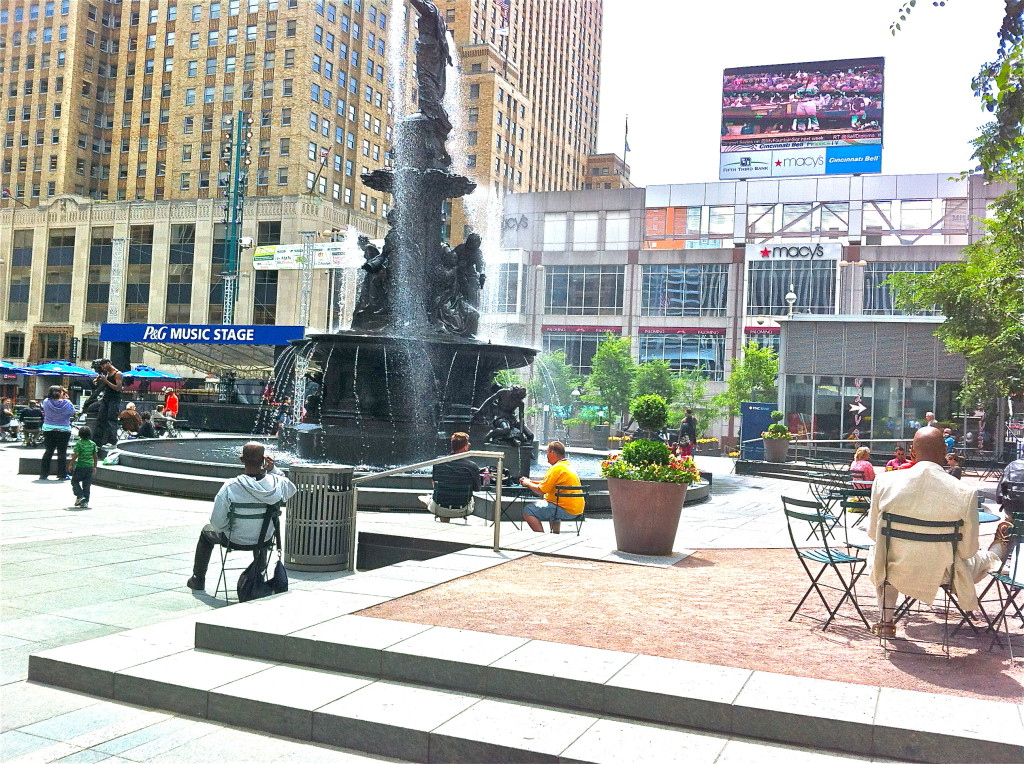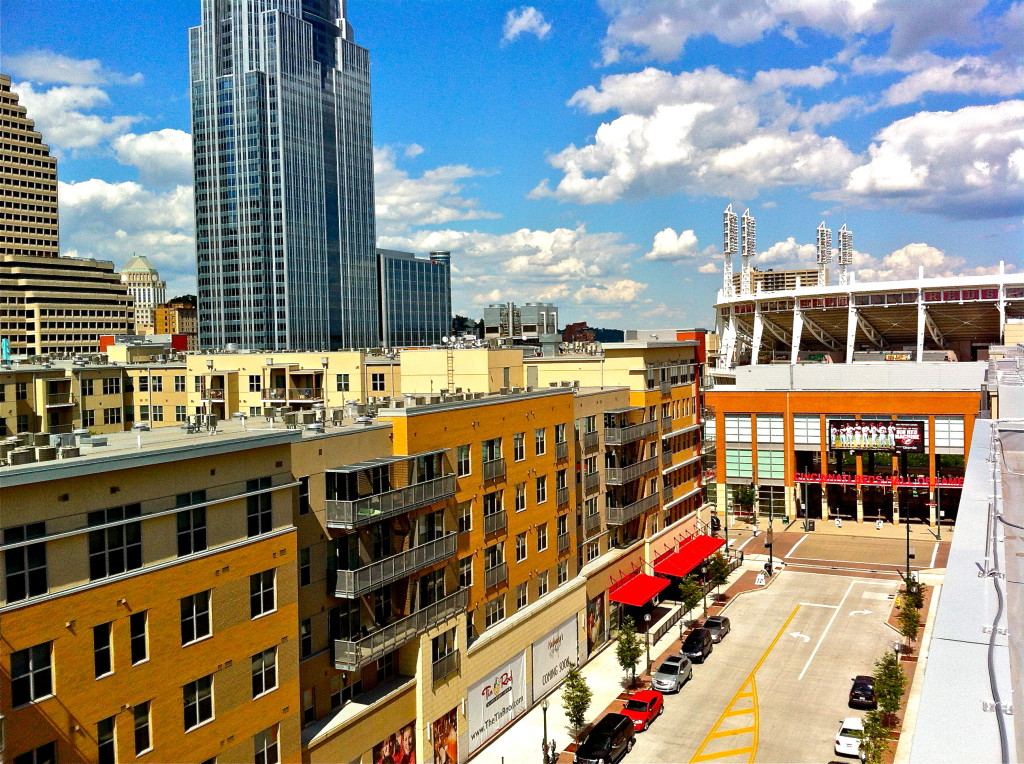
CINCINNATI – This 226-year-old Ohio River city came unglued in early April 2001, when three nights of riots and a plunge in the number of residents and businesses followed the death of an unarmed black man shot by the police.
Fourteen years later Cincinnati is climbing to the top of the heap of American midsize cities in real estate construction — a surge in investment and new buildings fostered not only by the hard work of social activists and human rights leaders, but also by scores of business starts, job growth, wage increases, public-private partnerships, and transit development that folowed. The city’s population, 297,517 in 2013 according to the US Census Bureau, grew over 600 residents, the first increase since 1950, when Cincinnati’s population peaked at 504,000 residents.
Cincinnati’s resurgence, based in large part on the development of a new big data industry and marketing analytics, is evidence of two powerful and promising trends reshaping the United States in the 21st century. The first is the pace of job growth in American cities, which now is faster than in the suburbs. (See my articles here in the New York Times.) The second is the recovery of the Rust Belt, and especially the strength of cities in the Ohio River Valley. In today’s New York Times I report on Cincinnati’s rise as a center of what city leaders call “consumer science.”
One measure of Cincinnati’s new relevance is the $85 million, 338,000-square-foot, 12-story office building that Atlanta-based Carter is building to house General Electric’s new Global Operations Center. Construction is due to be completed in 2016 in The Banks, an 18-acre Ohio riverfront development located between the city’s baseball and football stadiums. The building and the district will be served by a station stop on the 3.6 mile, $148 million Cincinnati streetcar line, scheduled to open the same year.
GE’s Operations Center, one of five the company is developing globally, contains first floor retail, parking on the second floor, 10 stories of conference and office space, and houses up to 2,000 GE professionals, 1,400 of them new to Cincinnati. The installation serves big development and manufacturing centers that GE operates in the U.S., including lighting and aviation manufacturing sites in two Ohio cities.
The center is being built with the help of $101 million in city, county, and state tax and investment incentives. In exchange GE committed to employ at least 1,800 people in Cincinnati over the next 18 years, earning a total payroll of $142 million annually to start, or an average of $79,000 a year.
“Cincinnati was chosen due to GE’s long-standing presence in the state and southwest Ohio,†said Dominic McMullan, a GE spokesman, “as well as a pool of local talent and skills required for the roles in the Global Operations Center. In addition, the state, county and city provided a competitive incentive package to GE.â€

Big Data Urban Economics
Another big project that is competing with GE for attention, and illustrates the Queen City’s powerful embrace of new market opportunities, is the dunnhumby Centre just a few blocks away. The $140 million, nine-story, 285,000-square-foot office building opens in the spring and will make the corner of Fifth and Race one of downtown’s most prominent addresses again.
Rising from a parcel that for more than a decade was a city-owned surface parking lot, the new building sits atop 29,000 square feet of ground floor retail space and a six-level, 527,000-square-foot parking deck. It is a joint project of dunnhumbyUSA and the Cincinnati Center City Development Corporation, the city’s non-profit real estate development organization, known here as 3CDC. It houses the fast growing staff of a market analytics firm jointly owned by a small British-owned big data analysis company and The Kroger Company, the grocery store chain, which is based here.
The story of dunnhumbyUSA’s development is emblematic of Cincinnati’s strong recovery following the 2001 riots.
The company got its start in 2003, two years after the civil disturbance, and during a period of social and economic reckoning in Cincinnati. The company had just four employees during that first year when public meetings were held and a federal task force investigated police relationships with the city’s African American community and recommended significant changes. Thirty percent of the police force is African American now, as is the chief of police.
The city’s big companies, in collaboration with Cincinnati and Hamilton County, also developed new plans and investment funds for park reconstruction, business investments, new office and residential construction, all aimed at coaxing residents to live downtown and to establish more high paying jobs.
Step By Step Back From The Brink
In 2005, Fountain Square, Cincinnati’s deteriorated cultural and economic center, was rebuilt, prompting new office and retail development nearby. By then, dunnhumby, housed in a downtown office not far from the square, had grown to almost 100 staffers. Some of the young workers moved into the first new apartments developed by 3CDC in the Over-the-Rhine district, the late 19th century neighborhood where the riot started.
Dunnhumby achieved its rapid growth by inventing the algorithms and big data analytics to help Kroger understand consumer buying habits. The firm’s analysts, for example, found that men and women in two-income households with children typically spend about 16 minutes in a Kroger store. That piece of data prompted new designs in product displays – like one-stop sections for preparing school lunches – in stores that served upper income single-family neighborhoods.
Dunnhumby’s clients include so many other big retailers and product companies, like Macy’s, which also is based in Cincinnati, that it now employs 750 analysts, programmers, software developers, and marketing specialists, nearly 600 of them working in the city.

The company’s new office building, large enough to house 1,100 employees, joins a host of other new or renovated buildings near Fountain Square, including the $56 million, 156-room, 21c Museum Hotel that opened in 2012 two blocks away.
“We see applications for our work across so many industries. Big data really has no barriers,†said Stuart Aitken, dunnhumbyUSA’s chief executive officer. “We have 35 or 40 job openings right now we’re trying to fill. We couldn’t be in a better place than this city.â€
The dunnhumby Centre is seen here as a kind of 21st century Kitty Hawk for a job generating data analysis sector that Cincinnati executives call “consumer science.†According to REDI Cincinnati, a regional business development organization, hundreds of consumer science data analytics firms now employ more than 54,000 professionals in Cincinnati and its near suburbs.
P&G Spawns An Industry
Their work is directed to strengthening the city’s core marketing companies, which include The Procter & Gamble Company and other large consumer products firms that employ over 60,000 more brand professionals in and around the city, according to REDI Cincinnati. “Consumer science developed very fast here,†said Johnna Reeder, REDI Cincinnati’s president and chief executive. “You can see it becoming visible in new offices, and in the demand for new apartments all over downtown.â€
Much of the focus of that interest is in Over-the-Rhine where 1,100 to 1,400 new residential units are either under development or planned over the next two years, said Anastasia Mileham, vice president of marketing and communications for 3CDC, the neighborhood’s principal developer.
That surge in interest follows $335 million in investment by 3CDC to renovate or construct new buildings for 176 apartments, 17 restaurants, 23 new offices, and 14 retail stores. The total includes $48 million to restore Washington Park, and build a parking deck underneath, a project completed in 2012.
3CDC is supervising the $130 million restoration of Music Hall, a 136-year-old, 3,300-seat performing arts theater in the district and home of the Cincinnati Symphony Orchestra. The project is financed by tax credits, city investments, grants and donations.
Over-the-Rhine, which a decade ago had 500 vacant buildings and 700 vacant lots, has become one of Cincinnati’s choice residential neighborhoods for young professionals and a busy downtown office, retail, and entertainment district.
On Martin Luther King Day a year ago, a civil rights group, The People’s Coalition for Equality and Justice, organized a demonstration to attract attention to housing displacement and hiring issues in Over-the-Rhine. Property values climbed over 25 percent in 2014, faster than any other Cincinnati neighborhood, according to Hamilton County figures.
City officials responded that the 40-square-block neighborhood, once riddled with vacant buildings and lots, has 1,000 units of affordable housing. 3CDC executives added that 30 of the 67 apartments in its four-year-old, $55 million Mercer Commons project are to be rented to families earning $26,000 a year or less.
“There’s been some public discussion about gentrification,†said Randy Simes, an urban planner and editor of UrbanCincy.com, a news site that reports on the city’s development. “Early on it is was less of an issue because there were so many empty properties. Now developers are coming in to buy properties that have residents. We’re finding that some are upset because they need to relocate. Others welcome the opportunity to get out of the neighborhood.â€
“So much is happening and it’s happening now so quickly,†said Ms. Mileham, a senior executive of a company that now employs 60 people and operates on a $5 million annual budget. “Cincinnati is really changing.â€
In December, 3CDC itself moved into a 28,000 square foot, four story, 86-year-old brick manufacturing warehouse on Walnut Street, renovated at a cost of $7.1 million. The building is a microcosm of contemporary Cincinnati. Its new tenants – a consumer science marketing firm, a law firm, a bar and restaurant, and an urban development agency – form four of the important food groups of the city’s new economy and culture.
— Keith Schneider


